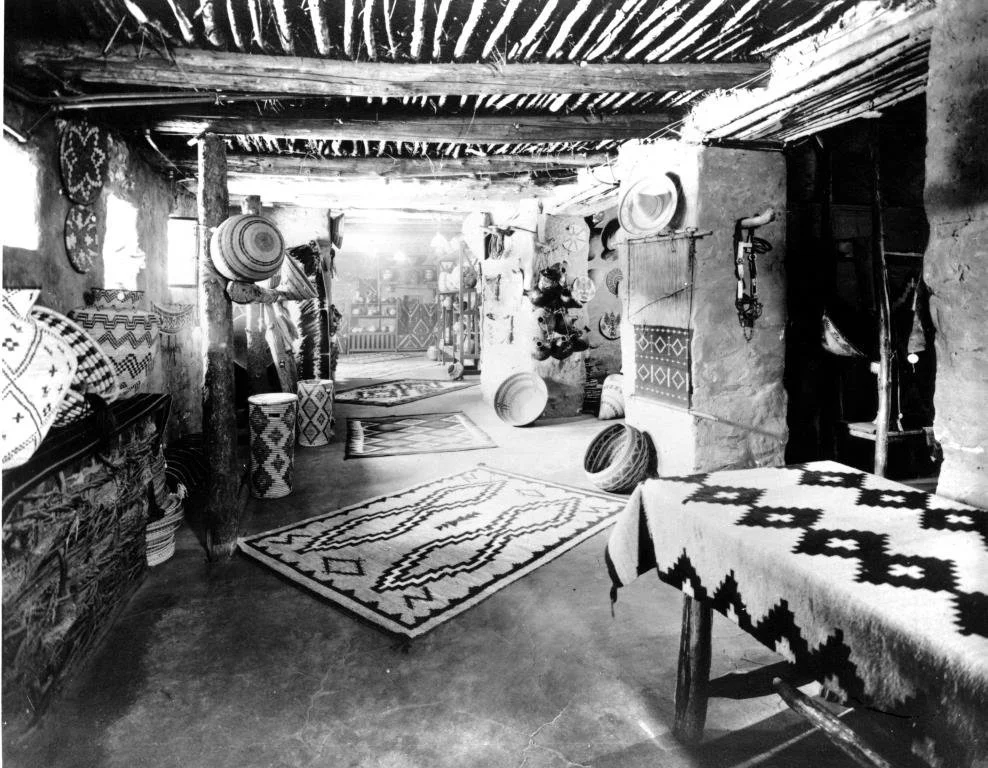Hopi House and Mary E. J. Colter
Artisan/Demonstrators posing in front of Hopi House, c. 1910. Fred Harvey/ GRCA 49356
Since its opening in 1905 near the El Tovar hotel, Hopi House at the Grand Canyon has sold hand-crafted objects made by American Indians. In its early days, Hopi House also housed some of the indigenous people who worked as artist-demonstrators in the building.
The hospitality company Fred Harvey, which worked closely with the Atchison, Topeka, and Santa Fe Railway on their Grand Canyon developments, managed the Hopi House. Like the train depot and El Tovar, Hopi House was built on part of the 20 acres that was the railway’s right-of-way next to the Grand Canyon’s rim.
Ground floor sales room, c. 1905. Detroit Photographic/ GRCA 15803c
While Hopi House is sometimes attributed entirely to architect and decorator Mary E. J. Colter (1869 – 1958), many others also contributed to its design. The exterior was modeled after a building in a Hopi village some 130 miles to the east. “If you have ever witnessed the Snake Dance at Oraibi, you may have seen on a side street the original of this picturesque building,” a 1908 Fred Harvey promotional booklet reads. The Grand Canyon’s Hopi House, the brochure continues, “looks like an Indian pueblo; and so it is, in miniature.” A drawing of the exterior was made by Santa Fe Railway architect W.H. Mohr in 1901.
Hopi House interior, c. 1905. Detroit Photographic/ GRCA 15803d
Colter worked with Santa Fe Railway architect Charles Whittlesey during the summer of 1902 when he was designing the El Tovar hotel, a project that was sometimes described as including a “curio room.” It is possible that Colter also contributed to the design of the interior architecture of Hopi House. The railway’s engineers helped adapt the design for retail and museum use. For example, they included steel rails as beams to allow wider interior openings than could otherwise be accommodated structurally.
Hopi House with El Tovar. GRCA 13661.
Hopi people worked on the building’s construction and built the fireplaces and chimneys to their own designs. Heinrich R. Voth was present for much of the construction and provided part of a museum exhibit when the Hopi House was complete. Voth had earned a reputation among Euro-Americans as an ethnologist owing to his ten years living among Hopi people as a Mennonite missionary. While he did not convert any Hopi, he did collect their crafts. He also documented and shared their private ceremonies in a manner inconsistent with today’s professional standards in ethnography. Some cultural objects installed by Voth were removed decades later in recognition of this transgression.
In December 1904, Colter traveled to the Grand Canyon to help arrange the wares in the Hopi House’s retail store before the building opened to the public the following month. It was her first trip there, but it was far from her last. She worked for Fred Harvey on numerous buildings at the Grand Canyon before her retirement in 1948, as well as contributing to the national park’s planning more broadly. Her Grand Canyon buildings include Desert View Watchtower and two other observatories and rest houses, Bright Angel Lodge, Phantom Ranch, and two employee dormitories.
Hopi House, 2006. NPS/Michael Quinn, 0076.
Please subscribe to The Architectress.
Sources:
Fred Harvey, “El Tovar: A New Hotel at Grand Canyon of the Arizona,” 1908.
George Wharton James, The Grand Canyon and How to See It (Boston: Little, Brown, & Company, 1910).
W. H. Simpson, “El Tovar: A New Hotel at Grand Canyon of Arizona,” Fred Harvey (c. 1908) .
W.H. Moh , perspective drawing and elevation drawings, “Proposed Hopi Building for Grand Canyon Rwy” (June 22, 1901), GRCA 109525, Grand Canyon Museum Collection.
Mary E.J. Colter biography typescript, Heard Museum Digital Library. c. 1948-1958.
Arnold Berke, Mary Colter: Architect of the Southwest. New York: Princeton Architectural Press, 2002.
Fred Eggan, “H.R. Voth, Ethnologist,” in Hopi Material Culture: Artifacts Gathered by H.R. Voth in the Fred Harvey Collection, Barton Wright (Flagstaff, Arizona: Northland Press, 1979).
John D. Thiesen, "The Contested Legacy of the First Mennonite Anthropologist, H. R. Voth." Journal of Mennonite Studies, 2021: 69-89.
“Harvey Officials,” Albuquerque Citizen, April 11, 1903.
“Grand Canyon Curio Room,” Albuquerque Morning Journal, April 17, 1903
“Building a Hopi House,” The Evening Kansan-Republican (November 15, 1904).
“Local Items of Interest,” Albuquerque Daily Citizen (December 19, 1904), 1.




